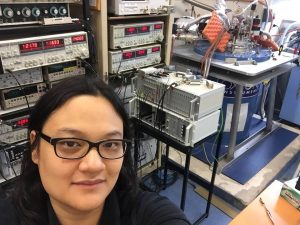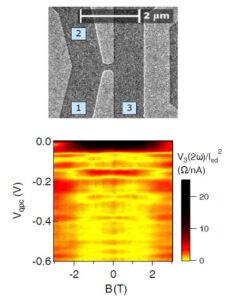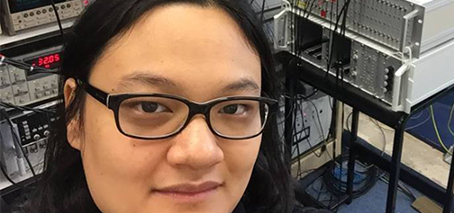
Lead author Dr Elizabeth Marcellina is a theoretical and experimental physicist, previously at UNSW and now at NTU, Singapore
Spin-filtering could be the key to faster, more energy-efficient switching in future spintronic technology, allowing the detection of spin by electrical rather than magnetic means.
A paper published last month by researchers at UNSW and international collaborators demonstrates spin detection using a spin filter to separate spin orientation according to their energies.
Ultra-fast, ultra-low energy ‘spintronic’ devices are an exciting, beyond-CMOS technology.
Detecting spin via electrical means in future spintronics
The emerging field of spintronic devices use the extra degree of freedom offered by particles’ quantum spin, in addition to its charge, allowing for ultra-fast, ultra-low energy computation.
The key is the ability to generate and detect spin as it accumulates inside electronic devices.
The goal is to generate and detect spin via electrical means, rather than magnetic means, because electric fields are a lot less energetically costly to generate than magnetic fields, and can be switched on and off much faster.
Energy-efficient spintronics is dependent on both generation and detection of spin via electrical means.
In strongly spin-orbit coupled semiconductor systems, all-electrical generation of spin has already been successfully demonstrated.
However, detection of spin-to-charge conversion in semiconductors has previously required large magnetic fields, limiting the speed and practicality.
In this new study, UNSW researchers have exploited the non-linear interactions between spin accumulation and charge currents in gallium-arsenide holes, demonstrating all-electrical spin-to-charge conversion without the need for a magnetic field.
“Our technique promises new possibilities for rapid spin detection in a wide variety of materials, without using a magnetic field,” explains lead author Dr Elizabeth Marcellina.
Previously, generation and detection of spin accumulation in semiconductors has been achieved through optical methods, or via the spin Hall effect-inverse spin Hall effect pair.
However, these methods require a large spin diffusion length, meaning that they are not applicable to strongly spin-orbit coupled materials with short spin diffusion length.
All-electrical spin filtering
The new study, a collaboration between researchers at UNSW, IBM Zurich, RIKEN in Japan and the University of Cambridge, introduces a new method for detecting spin accumulation—using a spin filter, which separates different spin orientations based on their energies.
Typically, spin filters have relied on the application of large magnetic fields, which is impractical and can interfere with the spin accumulation.

Top: Electron microscope image of the experimental device. Bottom: mapping the non-linear spin signal for different operating conditions.
Instead, Dr Fabrizio Nichele at IBM Research in Zurich suggested the team could exploit energy dependent tunnelling to perform a non-linear conversion of spin accumulation into charge currents even at zero magnetic field.
“We used semiconductor holes in a gallium arsenide nanostructure as a model system for strongly spin-orbit coupled materials, and demonstrated non-linear spin-to-charge conversion that is all-electrical and requires no magnetic field ” says project leader Prof Alex Hamilton (UNSW).
“We showed that the new non-linear spin-to-charge conversion technique is fully consistent with the data obtained from linear response measurements” adds senior author A/Prof Dimi Culcer (also at UNSW).
Because the non-linear method does not need a magnetic field nor a long spin diffusion length, it promises new possibilities for fast detection of spin accumulation in strongly spin-orbit coupled materials with short spin diffusion lengths, such as two dimensional transition metal dichalcogenides (TMDCs) and other topological materials.
Finally, the rapidness of non-linear spin-to-charge conversion could enable time-resolved read-out of spin accumulation with nanosecond resolution.
The study
A non-linear spin filter for non-magnetic materials at zero magnetic field was published in Physical Review B in October 2020. (DOI 10.1103/physrevb.102.140406)
The work was supported by the Australian Research Council (Discovery and Centres of Excellence programs) and the device was fabricated using facilities of the New South Wales Node of the Australian National Fabrication Facility (ANFF-NSW).
Ultra-low energy spintronics is one of several future technologies studied at FLEET, the Australian Research Council Centre of Excellence in Future Low-Energy Electronics Technologies.
More information
- Contact Professor Alex Hamilton alex.hamilton@unsw.edu.au
- Contact A/Prof Dimi Culcer d.culcer@unsw.edu.au


